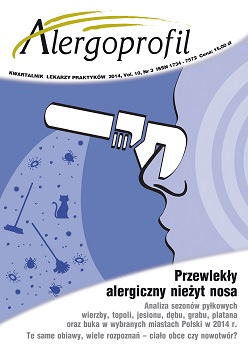Przewlekły alergiczny nieżyt nosa
##plugins.themes.bootstrap3.article.main##
Abstrakt
Przewlekły alergiczny nieżyt nosa jest w populacji polskiej najczęstszą postacią chorób alergicznych górnych dróg oddechowych. Czynnikiem etiologicznym są alergeny roztoczy kurzu domowego i alergeny zwierząt domowych. Ekspozycja na alergeny roztoczy kurzu domowego jest przez większość roku zbliżona, przy czym największa jest w chłodnych okresach roku. Jednym z głównych objawów przewlekłego alergicznego nieżytu nosa jest blokada (upośledzenie drożności) nosa. Terapia chorych z tym objawem wymaga wyjścia poza dotychczasowe standardy leczenia alergicznego nieżytu nosa.
Pobrania
##plugins.themes.bootstrap3.article.details##
Copyright: © Medical Education sp. z o.o. This is an Open Access article distributed under the terms of the Attribution-NonCommercial 4.0 International (CC BY-NC 4.0). License (https://creativecommons.org/licenses/by-nc/4.0/), allowing third parties to copy and redistribute the material in any medium or format and to remix, transform, and build upon the material, provided the original work is properly cited and states its license.
Address reprint requests to: Medical Education, Marcin Kuźma (marcin.kuzma@mededu.pl)
Bibliografia
2. Rapiejko P.: Alergiczny nieżyt nosa – 42 pytania i odpowiedzi. Medical Education, Warszawa 2014.
3. Samoliński B., Arcimowicz M. (red.): Polskie Standardy Leczenia Nieżytów Nosa (PoSLeNN). Alergologia Polska 2013, S 1.
4. Bousquet J., van Cauwenberge P., Khaltaev N.; ARIA Workshop Group; World Health Organization: Allergic rhinitis and its impact on asthma. J. Allergy Clin. Immunol. 2001; 108(5 Suppl): S147-334.
5. Samoliński B., Raciborski R., Lipiec A. et al.: Epidemiologia chorób alergicznych w Polsce ECAP. Alergologia Polska – Polish Journal of Allergology 2014: 1(1): 10-18.
6. Samoliński B., Rapiejko P., Lipiec A.: Metody ograniczania narażenia na alergen. W: Standardy w Alergologii. Kruszewski J., Kowalski M.L. Medycyna Praktyczna, Kraków 2010.
7. Corey J.P., Houser S.M., Ng B.A.: Nasal congestion: a review of its etiology, evaluation, and treatment. Ear Nose Throat J. 2000; 79(9): 690-698.
8. Wang D.Y., Raza M.T., Gordon B.R.: Control of nasal obstruction in perennial allergic rhinitis. Curr. Opin. Allergy Clin. Immunol. 2004; 4(3): 165-170.
9. Samoliński B., Rapiejko P.: Odpowiedź późna po donosowej próbie prowokacyjnej z alergenem. Postępy Dermatologii i Alergologii. XXVII(3)2010: 173-176.
10. Horak F., Zieglmayer U.P.: Azelastine nasal spray for the treatment of allergic and nonalergic rhinitis. Expert Rev. Clin. Immunol. 2009; 5(6): 659-669.
11. Meltzer E., Ratner P., Bachert C. et al.: Clinically Relevant Effect of a New Intranasal Therapy (MP29-02) in Allergic Rhinitis Assesssed by Responder Analysis. Int. Arch. Allergy Immunol. 2013; 161: 369-377.
12. Rapiejko P.: Zastosowanie azelastyny w postaci sprayu do nosa poprawia współpracę z chorymi na alergiczny nieżyt nosa. Alergoprofil 2013; 9(2): 5-10.
13. Samoliński B., Nowicka A., Wojas O. et al.: Intranasal glucocorticosteroids – Not only in allergic rhinitis in the 40th anniversary of intranasal glucocorticosteroids’ introduction. Otolaryngol. Pol. 2014; 68: 51-64.
14. Borres M.P., Bråkenhielm G., Irander K.: How many teenagers think they have allergic rhinoconjunctivitis and what they do about it. Ann. Allergy Asthma Immunol. 1997; 78: 29-34.
15. Craig T.J., Hanks C.D., Fisher L.H.: How do topical nasal corticosteroids improve sleep and daytime somnolence in allergic rhinitis? J. Allergy Clin. Immunol. 2005; 116: 1264-1266.
16. Young T., Finn L., Kim H.: Nasal obstruction as a risk factor for sleep-disordered breathing. The University of Wisconsin Sleep and Respiratory Research Group. J. Allergy Clin. Immunol. 1997; 99: 757-762.
17. Platt M.: Pharmacotherapy for allergic rhinitis. Int. Forum Allergy Rhinol. 2014; 4(Suppl. 2): 35-40.
18. Tanner L.A., Reilly M., Meltzer E.O. et al.: Effect of fexofenadine HCl on quality of life and work, classroom, and daily activity impairment in patients with seasonal allergic rhinitis. Am. J. Manag. Care 1999; 5(Suppl. 4): 235-247.
19. Juniper E.F., Guyatt G.H., Ferrie P.J., King D.R.: Sodium cromoglycate eye drops: regular versus „as needed” use in the treatment of seasonal allergic conjunctivitis. J. Allergy Clin. Immunol. 1994; 93: 413-423.
20. Corey J.P., Kemker B.J., Branca J.T. et al.: Health status in allergic rhinitis. Otolaryngol. Head Neck Surg. 2000; 122: 681-685.
21. Blanc P.D., Trupin L., Eisner M. et al.: The work impact of asthma and rhinitis: findings from a population-based survey. J. Clin. Epidemiol. 2001; 54: 610-618.
22. Marshall P.S., Colon E.A.: Effects of allergy season on mood and cognitive function. Ann. Allergy 1993; 71: 251-258.
23. Vuurman E.F., van Veggel L.M., Sanders R.L. et al.: Effects of semprex-D and diphenhydramine on learning in young adults with seasonal allergic rhinitis. Ann. Allergy Asthma Immunol. 1996; 76: 247-252.
24. Walker S., Sheikh A.: Rhinitis – 10-minute consultation. BMJ 2002; 324: 403.
25. Brożek J.L., Bousquet J., Baena-Cagnani C.E. et al.: Allergic rhinitis and its impact on asthma (ARIA) guidelines: 2010 revision. J. Allergy Clin. Immunol. 2010; 126: 466-476.
26. Carr W.W., Bernstein J., Lieberman P. et al.: A novel intranasal therapy of azelastine with fluticasone for the treatment of allergic rhinitis. J. Allergy Clin. Immunol. 2012; 129: 1282-1289.
27. Carr W.W., Ratner P., Munzel U. et al.: Comparison of intranasal azelastine to intranasal fluticasone propionate for symptoms control in moderate-to-severe seasonal allergic rhinitis. Allergy Astma Proc. 2012, 33: 450-458.
28. Hampler F.C., Rather P.H., van Baval J. et al.: Double blind, placebo controlled study if azelastine and fluticasone in a single nasal spray delivery device. Ann. Allergy Asthma Immunol. 2010; 105: 168-173.
29. Meltzer E., Ratner P., Bachert C. et al.: Clinically Relevant Effect of a New Intranasal Therapy (MP29-02) in Allergic Rhinitis Assesssed by Responder Analysis. Int. Arch. Allergy Immunol. 2013; 161: 369-377.
30. Thomas KE., Ollier S., Ferguson H., Davies R.J.: The effect of intranasal azelastine, Rhinolast, on nasal airways obstruction and sneezing following provocation testing with histamine and allergen. Clin. Exp. Allergy 1992; 22: 642-647

